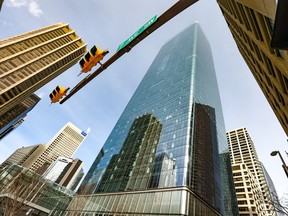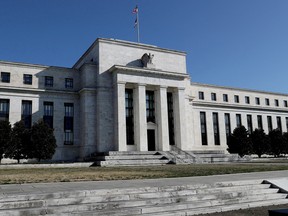Breadcrumb Trail Links
Higher interest rates are reducing the value of commercial real estate
Published Mar 28, 2023 • Last updated 18 hours ago • 6 minute read
 The Brookfield Place building in Calgary. Photo by Gavin Young/Postmedia files
The Brookfield Place building in Calgary. Photo by Gavin Young/Postmedia files
Article content
Rapidly rising interest rates have exposed weaknesses in the United Kingdom’s pension system and sparked a banking crisis in the United States and Europe. Now economists, investors and authorities on the lookout for other potential problem spots in the global financial system.
Advertisement 2
This advertisement has not loaded yet, but your article continues below.
THIS CONTENT IS RESERVED FOR SUBSCRIBERS ONLY
Subscribe now to read the latest news in your city and across Canada.
- Unlimited online access to articles from across Canada with one account
- Get exclusive access to the National Post ePaper, an electronic replica of the print edition that you can share, download and comment on
- Enjoy insights and behind-the-scenes analysis from our award-winning journalists
- Support local journalists and the next generation of journalists
- Daily puzzles including the New York Times Crossword
SUBSCRIBE TO UNLOCK MORE ARTICLES
Subscribe now to read the latest news in your city and across Canada.
- Unlimited online access to articles from across Canada with one account
- Get exclusive access to the National Post ePaper, an electronic replica of the print edition that you can share, download and comment on
- Enjoy insights and behind-the-scenes analysis from our award-winning journalists
- Support local journalists and the next generation of journalists
- Daily puzzles including the New York Times Crossword
REGISTER TO UNLOCK MORE ARTICLES
Create an account or sign in to continue with your reading experience.
- Access articles from across Canada with one account
- Share your thoughts and join the conversation in the comments
- Enjoy additional articles per month
- Get email updates from your favourite authors
Article content
Though the next flare up can be hard to predict, those who have seen prior crises say that tightening credit following an initial shock, high leverage and a mismatch in the timeframe for borrowing and lending are all potential catalysts.
 By clicking on the sign up button you consent to receive the above newsletter from Postmedia Network Inc. You may unsubscribe any time by clicking on the unsubscribe link at the bottom of our emails or any newsletter. Postmedia Network Inc. | 365 Bloor Street East, Toronto, Ontario, M4W 3L4 | 416-383-2300
By clicking on the sign up button you consent to receive the above newsletter from Postmedia Network Inc. You may unsubscribe any time by clicking on the unsubscribe link at the bottom of our emails or any newsletter. Postmedia Network Inc. | 365 Bloor Street East, Toronto, Ontario, M4W 3L4 | 416-383-2300
Thanks for signing up!
Article content
“The next place where things usually blow up in rising interest rate environments is situations where (institutions) were playing the carry trade — borrowing short term and lending long term,” said Jim Keohane, a director at Alberta Investment Management Corp. and a longtime pension executive.
He, like others, is predicting trouble in commercial real estate, a sector already under pressure due to the rising interest rates combined with vacancies and lower rents that have lingered following stay-at-home and work-from-home orders during the COVID-19 pandemic.
Advertisement 3
This advertisement has not loaded yet, but your article continues below.
Article content
“Because these two factors are coming into play at the same time, I would expect that there will be significant writedowns coming on office and commercial real estate,” Keohane said.
Even in times when rents are stable, which they’re not right now, climbing interest rates alone will cause the value of such buildings to decline, Keohane said. That’s because office towers trade or are valued based on a “cap rate” — essentially the cash flow from rent divided by the cost of the building.
As market interest rates climb, the value of buildings has to reflect the reality of higher financing costs for purchasers of those buildings. So even if rents are stable, the value of the building will drop. Higher rates reduce the value of commercial real estate in the same way that they cause the value of bonds to decline.
Article content
Advertisement 4
This advertisement has not loaded yet, but your article continues below.
Article content
If interest rates are rising as rents are falling, as is the case now, the building’s valuation goes down even further.
In an example Keohane gave, a two percentage point rise in interest rates from five to seven per cent — on a building with $5 million in rental income — would drop the building’s valuation by 28.5 per cent. If rents fell by 20 per cent at the same time, the tower’s valuation would fall 42.9 per cent.
Though he noted that other factors come into play in the valuation of commercial real estate, signs of stress are already appearing in the sector.
In February, it was widely reported that a subsidiary of Brookfield Corp. defaulted on US$755 million in loans on two office buildings in Los Angeles, walking away from the loans rather than refinancing.
Advertisement 5
This advertisement has not loaded yet, but your article continues below.
Article content
The situation is being watched closely in the United States where hundreds of small and mid-sized banks — already roiled by fears of a bank run after the stunning collapse of Silicon Valley Bank and Signature Bank in March — hold an outsized portion of commercial real estate lending.
 A Silicon Valley Bank branch in Santa Monica, California. Photo by TRICK T. FALLON/AFP via Getty Images files
A Silicon Valley Bank branch in Santa Monica, California. Photo by TRICK T. FALLON/AFP via Getty Images files
A Goldman Sachs research report published March 19 estimated that banks with less than US$180 billion in assets hold around 70 per cent of commercial real estate loans in the banking system on their balance sheets.
Meanwhile, at U.S. regional banks with between US$10 billion and US$20 billion in assets, 25 per cent of their loans are tied to commercial real estate.
Bad loans or asset writedowns, even if the losses aren’t realized, would exacerbate issues already shaking this segment of the banking industry, including potential liquidity issues stemming from a flight of deposits to larger banks. Plummeting valuations of assets on their books could require the banks to hold more regulatory capital, which they would need to obtain through either selling assets or shares, or some other capital infusion.
Advertisement 6
This advertisement has not loaded yet, but your article continues below.
Article content
If smaller banks start to topple or get absorbed by competitors as a result, credit could tighten further, spreading problems beyond the financial services sector.
“In the current environment of financial instability and credit tightening, leverage and liquidity are quick channels for transmitting spillover effects,” said Dinesh Gajurel, an associate professor in the faculty of management at the University of New Brunswick, whose research includes financial crises and contagion.
“In addition to the financial sector, the real estate sector and small businesses are also vulnerable to these effects.”
Gajurel said with the problems stemming from rising rates become more evident by the day, he was at a loss to explain why the U.S. Federal Reserve raised interest rates yet again on March 22.
Advertisement 7
This advertisement has not loaded yet, but your article continues below.
Article content
 The Federal Reserve building in Washington. Photo by Leah Millis/Reuters/File Photo
The Federal Reserve building in Washington. Photo by Leah Millis/Reuters/File Photo
“An increased interest rate further reduces credit (and) lending, creating more real economic consequences,” he said.
As worries about wider fallout and potential contagion from the U.S. banking problems rise, market watchers say derivatives could be an accelerant, as they have been in past crises.
“Derivative products, including MBS (mortgage-backed securities), are highly sensitive to their underlying assets,” said Gajurel.
Commercial mortgage backed securities (CMBS), which are not unlike the structured credit entities containing residential subprime mortgages that exposed risk and triggered contagion and bank bailouts during the 2008 financial crisis, are being closely watched because of the stress already evident in loans to office buildings and retail complexes.
Advertisement 8
This advertisement has not loaded yet, but your article continues below.
Article content
If this scenario plays out there will be significant losses
Jim Keohane
These securities are backed by pools of commercial mortgages, and a typical capital structure includes a series of tranches from higher risk and higher return to lower risk and lower return. When there are defaults in the mortgage pool, the highest-risk tranche takes the first losses. Once that tranche is exhausted, the next riskiest tier takes the losses, and so on.
“Even in the (typical) 80 per cent loan-to-value structures, if you write down the value of the building by 30 per cent, probably the first two or three tranches get wiped out,” Keohane said, noting commercial mortgage backed securities are typically sold to institutional investors such as pension plans but some may be held by banks as well.
“If this scenario plays out there will be significant losses.”
Advertisement 9
This advertisement has not loaded yet, but your article continues below.
Article content
Banks are going to suffer
Lawrence White
Lawrence White, an economics professor at New York University’s Stern School of Business, said commercial real estate blow-ups have occurred several times in the United States since the late 1970s, wiping out more than 1,000 financial institutions by the end of the 1980s in the savings and loan crisis, yet bankers seem unable to resist leaning in for the good times.
“It’s a nice way to make a living as long as interest rates stay stable or decline, but if interest rates go up, I’ll have to use a technical term in economics here: You’re screwed,” said White, who worked at the U.S. Department of Justice in the 1980s.
“Banks are going to suffer.”
White, who also sat on the board of the U.S. Federal Home Loan Mortgage Corp., or Freddie Mac, in the 1980s, said his mind turns to money market funds when he ponders the risks of leverage in the current crisis.
Advertisement 10
This advertisement has not loaded yet, but your article continues below.
Article content
While they are viewed as safe and liquid investments, past blowups have exposed their risks, including vulnerability to overwhelming demands for redemptions that resemble bank runs, such as the one that took place after the collapse of Lehman Brothers in September of 2008. That drained more than $300 billion from prime money market funds, with the heaviest redemptions coming from institutional funds, a run that was halted only when U.S. authorities intervened with guarantees and government liquidity facilities.
When money market funds can’t make good on returning each dollar at par, and there are losses, this is referred to as “breaking the buck.”
And while such events have been rare, White said leverage within money market funds is essentially “infinite” because, unlike banks, they aren’t required to hold capital in case of trouble.
Advertisement 11
This advertisement has not loaded yet, but your article continues below.
Article content
-

Work-from-home creates mortgage-backed securities default risk
-

RELPs, REITs give commercial real estate exposure, but are different
-

RioCan REIT can absorb Bed Bath & Beyond Canada ‘tenant failures:’ CEO
The money they take in from investors is used to buy short-term securities including treasury bills, commercial paper and repos that are supposed to be fairly liquid. But, as Canadian investors learned when the market for asset-backed commercial paper seized up in 2008, this is not always the case.
“They’re taking in money, that is a liability,” White said. “And there’s no capital to serve as a loss absorbing buffer, so I would worry about the money market mutual funds.”
Widespread runs on money market funds would be “traumatic” for the financial system, he said.
And though he expects U.S. authorities would step in again to staunch further spread and mitigate stock market losses and hits to corporate profits, this type of intervention could be seen as a distraction from efforts to tame inflation, prompting fresh concerns and repercussions.
“These are never good events for the financial markets,” White said.
• Email: [email protected] | Twitter: BatPost
Share this article in your social network
Comments
Postmedia is committed to maintaining a lively but civil forum for discussion and encourage all readers to share their views on our articles. Comments may take up to an hour for moderation before appearing on the site. We ask you to keep your comments relevant and respectful. We have enabled email notifications—you will now receive an email if you receive a reply to your comment, there is an update to a comment thread you follow or if a user you follow comments. Visit our Community Guidelines for more information and details on how to adjust your email settings.














